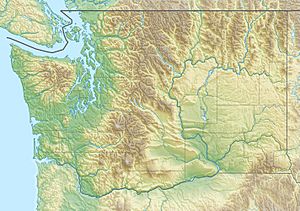Grays River (Washington) facts for kids
Quick facts for kids Grays River |
|
|---|---|
|
Location of the mouth of Grays River in Washington
|
|
| Country | United States |
| State | Washington |
| County | Wahkiakum, Pacific |
| Physical characteristics | |
| Main source | Willapa Hills 46°28′57″N 123°23′46″W / 46.48250°N 123.39611°W |
| River mouth | Grays Bay Columbia River 0 ft (0 m) 46°18′10″N 123°41′18″W / 46.30278°N 123.68833°W |
| Length | 30 mi (48 km) |
| Basin features | |
| Basin size | 124 sq mi (320 km2) |
The Grays River is a river about 30 miles (48 km) long in southwestern Washington state, USA. It flows into the mighty Columbia River, being one of the last rivers to join it on the Washington side. The Grays River collects water from low hills north of where the Columbia River meets the ocean.
The River's Journey
The Grays River begins in the eastern Willapa Hills in Pacific County, Washington. It flows generally southwest through Wahkiakum County. The river has three main branches, called forks: the East Fork, South Fork, and West Fork Grays River.
After the West Fork joins, the main river valley becomes wider. A road called Washington State Route 4 follows the valley, passing through the small towns of Grays River and Rosburg. Other smaller streams, like Fossil Creek and Hull Creek, also join the Grays River.
About 5 miles (8 km) southwest of the town of Grays River, the river flows into a wide area of the Columbia River's tidal estuary. An estuary is where a river meets the sea, and the water is a mix of fresh and saltwater, affected by tides. This area is called Grays Bay. The Grays River becomes tidal (meaning its water level changes with the ocean tides) at the town of Grays River. Closer to its mouth, especially past Rosburg, the river gets much wider because of these tides.
The hills and ridges that separate the Grays River's watershed (the area of land that drains into the river) from other rivers are known as the Grays River Divide. Rivers like the Elochoman River, Chehalis River, Willapa River, and Naselle River have their watersheds on the other side of this divide. The short Deep River is just west of Grays River and also flows into Grays Bay.
A Look Back in Time
The Grays River has an interesting history. In 1841, Charles Wilkes of the United States Exploring Expedition mapped the river and called it "Ebokwol." Later, in 1853, it was given another Native American name, "Moolhool," used by the Chinookan-speaking people who lived in the area.
The river and Grays Bay are named after Robert Gray. He was an American fur trader and captain of the ship Columbia Rediviva. In May 1792, Captain Gray and his crew were the first non-Native Americans to enter the mouth of the Columbia River. After exploring and trading for a few days, his ship briefly got stuck on a sandbar in what is now Grays Bay.
Captain Gray decided not to go further up the Columbia River. Instead, he stayed in Grays Bay for several days to trade and fix his ship. He went ashore and made a map of Grays Bay and the mouth of the Grays River. A copy of this map was given to George Vancouver, another explorer. Later, in October 1792, Vancouver's officer, William Robert Broughton, explored the Columbia River. It was Broughton, using Gray's map, who named Grays Bay and Grays River after Robert Gray.
A special landmark on the river is the Grays River Covered Bridge in the community of Grays River. This bridge is listed on the National Register of Historic Places. It is one of the very few covered bridges still used today in Washington state.
River Life and Wildlife
The Grays River is home to several types of fish. You can find coho salmon, sea-run coastal cutthroat trout, and winter-run steelhead here. While the number of coho salmon and cutthroat trout is not very high, the steelhead fish are a popular catch for people who enjoy sport fishing. Also, Sturgeon fish can be found just outside the river's mouth in Grays Bay.
In the past, there were many more fish in the Grays River. For example, estimates suggest there used to be thousands of chinook salmon, chum salmon, and coho salmon. Today, the numbers are much lower for natural spawning returns.
When the fish migrate (travel upriver to lay eggs), sea lions are often seen in the river, as they come to hunt the fish.
Fun on the River
The Grays River is a great place for outdoor activities. It is a popular spot for whitewater rafting and kayaking, offering exciting adventures for those who love water sports.


